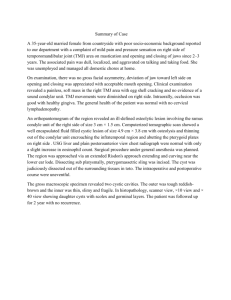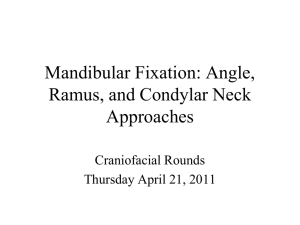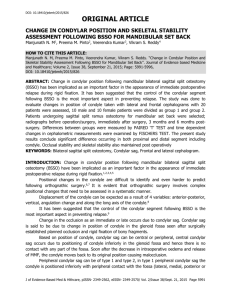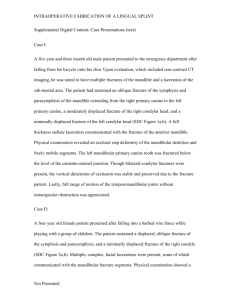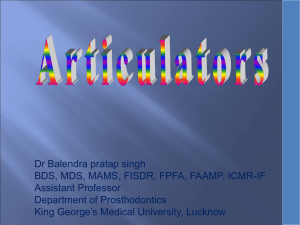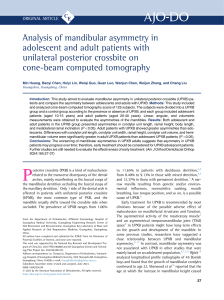A radiographic evaluation of mandibular asymmetry in Class II
advertisement
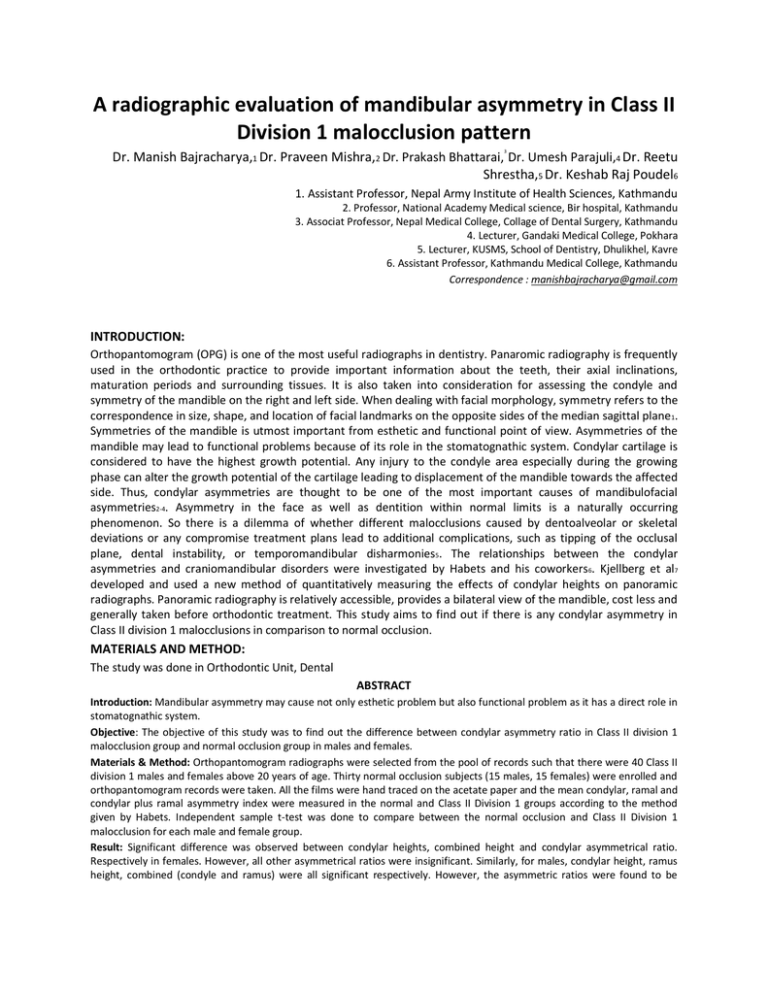
A radiographic evaluation of mandibular asymmetry in Class II Division 1 malocclusion pattern 3 Dr. Manish Bajracharya,1 Dr. Praveen Mishra,2 Dr. Prakash Bhattarai, Dr. Umesh Parajuli,4 Dr. Reetu Shrestha,5 Dr. Keshab Raj Poudel6 1. Assistant Professor, Nepal Army Institute of Health Sciences, Kathmandu 2. Professor, National Academy Medical science, Bir hospital, Kathmandu 3. Associat Professor, Nepal Medical College, Collage of Dental Surgery, Kathmandu 4. Lecturer, Gandaki Medical College, Pokhara 5. Lecturer, KUSMS, School of Dentistry, Dhulikhel, Kavre 6. Assistant Professor, Kathmandu Medical College, Kathmandu Correspondence : manishbajracharya@gmail.com INTRODUCTION: Orthopantomogram (OPG) is one of the most useful radiographs in dentistry. Panaromic radiography is frequently used in the orthodontic practice to provide important information about the teeth, their axial inclinations, maturation periods and surrounding tissues. It is also taken into consideration for assessing the condyle and symmetry of the mandible on the right and left side. When dealing with facial morphology, symmetry refers to the correspondence in size, shape, and location of facial landmarks on the opposite sides of the median sagittal plane1. Symmetries of the mandible is utmost important from esthetic and functional point of view. Asymmetries of the mandible may lead to functional problems because of its role in the stomatognathic system. Condylar cartilage is considered to have the highest growth potential. Any injury to the condyle area especially during the growing phase can alter the growth potential of the cartilage leading to displacement of the mandible towards the affected side. Thus, condylar asymmetries are thought to be one of the most important causes of mandibulofacial asymmetries2-4. Asymmetry in the face as well as dentition within normal limits is a naturally occurring phenomenon. So there is a dilemma of whether different malocclusions caused by dentoalveolar or skeletal deviations or any compromise treatment plans lead to additional complications, such as tipping of the occlusal plane, dental instability, or temporomandibular disharmonies5. The relationships between the condylar asymmetries and craniomandibular disorders were investigated by Habets and his coworkers6. Kjellberg et al7 developed and used a new method of quantitatively measuring the effects of condylar heights on panoramic radiographs. Panoramic radiography is relatively accessible, provides a bilateral view of the mandible, cost less and generally taken before orthodontic treatment. This study aims to find out if there is any condylar asymmetry in Class II division 1 malocclusions in comparison to normal occlusion. MATERIALS AND METHOD: The study was done in Orthodontic Unit, Dental ABSTRACT Introduction: Mandibular asymmetry may cause not only esthetic problem but also functional problem as it has a direct role in stomatognathic system. Objective: The objective of this study was to find out the difference between condylar asymmetry ratio in Class II division 1 malocclusion group and normal occlusion group in males and females. Materials & Method: Orthopantomogram radiographs were selected from the pool of records such that there were 40 Class II division 1 males and females above 20 years of age. Thirty normal occlusion subjects (15 males, 15 females) were enrolled and orthopantomogram records were taken. All the films were hand traced on the acetate paper and the mean condylar, ramal and condylar plus ramal asymmetry index were measured in the normal and Class II Division 1 groups according to the method given by Habets. Independent sample t-test was done to compare between the normal occlusion and Class II Division 1 malocclusion for each male and female group. Result: Significant difference was observed between condylar heights, combined height and condylar asymmetrical ratio. Respectively in females. However, all other asymmetrical ratios were insignificant. Similarly, for males, condylar height, ramus height, combined (condyle and ramus) were all significant respectively. However, the asymmetric ratios were found to be insignificant. There is a significant difference between Class II division 1 malocclusion and normal occlusion group in terms of condylar asymmetry ratio in female subjects. However, it was not significant in case of male subjects. Conclusion: Our study suggests that females with Class II division 1 malocclusion more prone to TMD in comparison to males. Key words: Class II Division 1, Condylar asymmetry, Orthopantomogram ORIGINAL ARTICLEPage 16 Department, National Academy of Medical Sciences, Bir Hospital. Two groups were divided consisting of 80 Class II Division 1 malocclusion (40 males, 40 females) and 30 normal occlusion subjects (15 males, 15 females). The normal occlusion group consisted of subjects of age group above 20 years; full complement of teeth present except the third molars; Class I molar and canine relation; normal over jet and overbite; minor or no crowding; normal growth and development with good alignment of upper and lower arches; good facial symmetry determined clinically; no significant medical history; no history of facial trauma, no previous orthodontic, prosthodontic or maxillofacial or plastic surgery; no signs and symptoms of TMJ dysfunction. Similarly for Class II Division 1 malocclusion case consisted of subjects with age group above 20 years; full cusp class II with overjet more than 5 mm; full complement of teeth with the exception of third molars; no history of previous orthodontic and prosthodontic treatment; no any history of facial trauma; no any congenital and dentofacial abnormalities present; a good quality OPG radiograph; no any signs and symptoms of TMJ dysfunction. Intraoral photographs and plaster models were used to classify patients according to their malocclusion. Two operators evaluated the subjects clinically for determining the fulfillment of the inclusion criteria of the selected samples. All the OPG radiographs classified as class II patients were collected from the records in the Dental department. Radiographs of the patients meeting the inclusion criteria were randomly selected such that there will be equal number of males and females of 40 each. For the normal occlusion group, 15 males and 15 females each ranging from 20 to 32 years of age were enrolled. Orthopantomogram radiographs were taken after their verbal and informed consent. The radiographic machine used for all the patients was Rotaplus model 9308525XOY with maximum exposure of 17 seconds. The line frequency was 50Hz. The mean enlargement of the image was 1.2:1. The inherent filtration of the PAN cassette was 1mm Al eq at 70 Kvp. All the radiographs were taken by the same operator to avoid interoperator variation. The OPG was taken with lip in relaxed position and the head oriented to the Natural head position. All the films were hand traced by the same operator on the acetate paper and the mean condylar, ramal and condylar plus ramal asymmetry index were measured in the normal and Class II Division 1 groups according to the method given by Habets et al8. The landmarks are shown in Figure 1. The borders of the condyle, neck, ramus and corpus of both sides of the mandible were traced. A line was drawn such that it is tangent to the ramus (Line A) and that it contacted the most lateral points on the condyle (L1) and the ascending ramus (L2). To the tangent of the ramus (Line A), a perpendicular line was drawn such that it passed through the most superior point of the condyle (Line B). The perpendicular distance between L1 and Line B was called the condylar height (CH). The distance between L1 and L2 was called the ramus height (RH). All the measurements were obtained with the help of vernier caliper (Mitutoyo SER No. 60325791 Japan) for linear which recorded up to 0.02 mm. To measure the asymmetry index the following formula was used: Asymmetry index = CH right- CH left X 100 CH right +CH left One month after the first measurements, 10 OPGs from the normal group and 20 OPGs from the study group were randomly selected and reexamined by the same operator. Dalburgs formula was applied to check for intraexaminer variation in the measurement. The value obtained was 0.51 to 0.92. The scores and grouping criteria were entered into a SPSS software package version 17.0. Independent sample t-test was done to compare between the normal occlusion and Class II Division 1 malocclusion for each male and female groups. Landmarks: Figure 1: Measurements of the asymmetry index according to Habets et al. (L1 and L2: Most lateral points of the tracing of the condyle and ramus of the OPG; Line A: Ramus tangent; Line B: Perpendicular line from A to the most superior part of the condylar image; CH: Condylar Height; RH: Ramus Height) RESULTS: The results show that there is significant difference between condylar heights (right and left), combined height (right and left) and condylar asymmetrical ratio. (p =0.000, p=0.000, p=0.010, p=0.003, p=0.049) respectively in females. However, all other asymmetrical ratios are insignificant (Table 1). Similarly, for males, condylar height (right and left), ramus height (right and left), combined (condyle and ramus) are all significant (p= 0.003, p=0.07, p=0.09, p=0.40, p=0.001, p=0.009 respectively). However, the asymmetric ratios are all insignificant (Table 2). Table 1: Comparison between Normal occlusion and Class II Div 1 (females) Normal occlusion Mean Class II Div 1 P Value Significance SD M S e D a n Right condylar height 7.83 1.71 5.11 1.30 .000 *** Left condylar height 7.06 1.66 5.00 1.33 .000 *** Right height ramus 49.60 3.75 48.00 5.59 .317 NS Left height ramus 49.66 3.84 46.95 5.50 .090 NS Right combined height 57.43 3.88 53.11 5.68 .010 * Left combined height 56.73 3.85 51.95 5.33 .003 *** Condylar asymmetrical ratio 7.84 7.37 8.66 8.08 .049 * Ramus asymmetrical ratio 2.47 2.30 2.55 2.65 .926 NS Combined asymmetrical ratio 2.19 1.82 2.27 2.33 .917 NS
